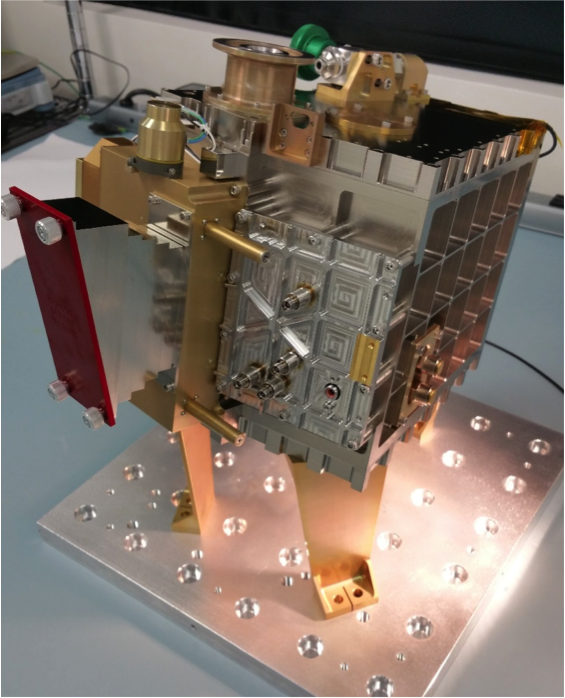The EUV instrument measures the 61.7 nm and 83.4 nm emissions with a spectrograph that provides spectral information in one dimension (horizontal) and the altitude distribution of the airglow brightness in the other (vertical) on a 2D detector. Each measurement provides 1D altitude information of the Earth’s horizon (limb). As the spacecraft moves, multiple measurements are combined to provide a 2D picture of the ionosphere.

The flight instrument has a red cover over the baffle helps keep the instrument clean and will be removed prior to launch.
The components of the ICON-EUV spectrograph are illustrated in Figure 3. Light from the Earth’s horizon enters the instrument through the entrance baffle and slit. A diffraction grating is used to disperse the spectrum on light in the horizontal dimension, while also focusing the image of the horizon onto the sensor. Light from other frequencies outside of the desired range is obstructed by the baffles. The sensor, a cross-delay-line detector (XDL) detects the arrival of each photon of light and determines its horizontal and vertical position. Fast read-out electronics and an onboard processor collect this information and produce a 2D image, with altitude on the vertical axis and wavelength on the horizontal axis. The EUV instrument produces one of these images every 12 seconds.
At EUV wavelengths, contamination by particles and organic compounds can severely affect the performance of the instrument. For this reason, the entire spectrograph is housed in a vacuum-tight housing. During the building and testing of the instrument, tests are performing using optical witness samples, introduced through a port on the top of the instrument, to determine if any contamination has occurred and take steps before the instrument is launched. As the entire housing is sealed, the adjustment of the diffraction grating is performed using 3 adjusters that can be moved without the need to open the instrument. Finally, a door seals the entire instrument until it is in orbit.

Model diagram of the ICON EUV spectrograph with the outside cover on

Model diagram of the ICON EUV spectrograph with the outside cover off